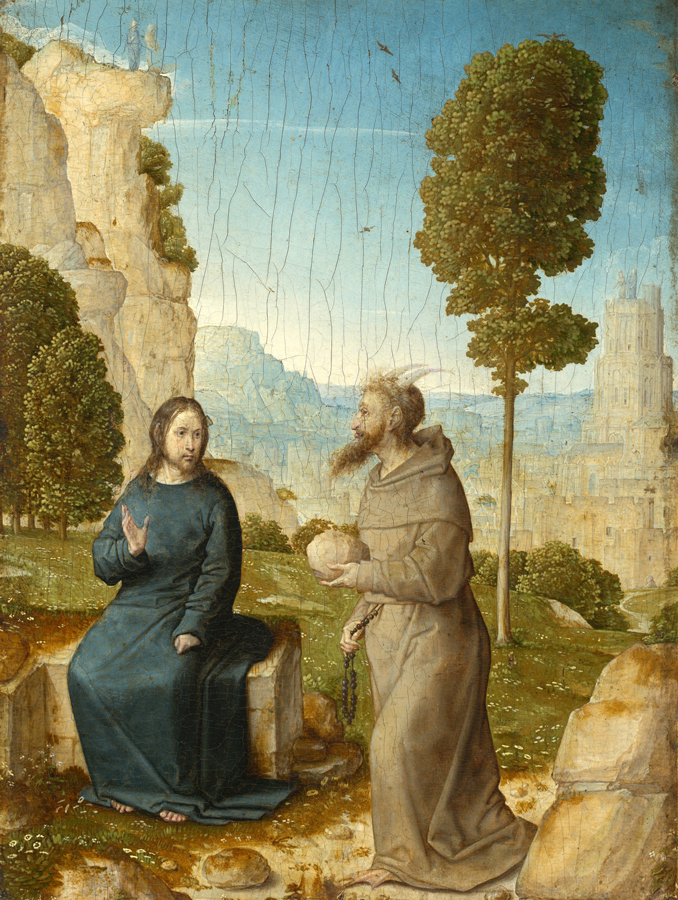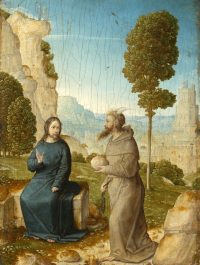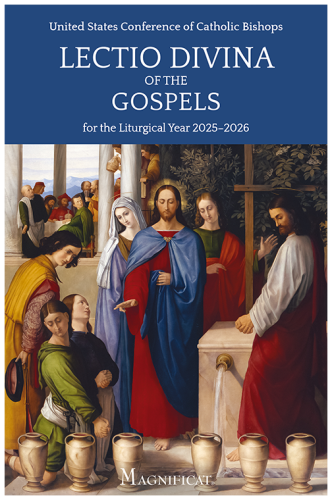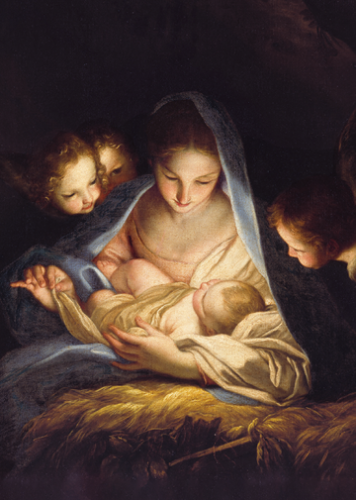The Temptation of Christ (c. 1500/1504),
Juan de Flandes (15th–16th century).
United in the mystery
As the season of Lent begins this month, the Church invites us to be united to the mystery of Jesus in the desert (CCC 540). The concrete time and place of the forty days when the Spirit drove Jesus out into the desert (Mk 1:12) are far away, yet the event remains relevant, timely, and concrete for the faithful today and in every age and place. This small painting from the early 16th century, The Temptation of Christ, testifies to that. A work commissioned centuries ago by the pious Queen Isabella the Catholic of Spain, it now hangs in the National Gallery of Art in Washington, DC. Even in its current setting, and reproduced in these pages, it continues to offer a meditation on this episode in the life of Christ, bringing the faithful closer to the reality of the event and its meaning.
In this pictorial version of the story, we do not see the wild beasts or ministering angels which Saint Mark refers to in his brief account, which is read at Mass on the First Sunday of Lent this year. Instead, in a likewise condensed version, as it were, we have a close-up view of one scene of the Temptation, with two miniature scenes in the distant background. The artist uses just three pigments of blue, green, and brown to represent the figures, the landscape, and the action.
The Battle is on
Small in size and necessarily silent, the depiction is nevertheless dramatic. In the front and center of the painting is Satan. He seems to be just passing by, strolling along a path as he approaches Jesus, who is seated on a stone wall. It is a moment of vanquish; Jesus will defeat the Tempter—not with his army of angels, lightning flashes, or fiery sword, but by total obedience to the divine will (CCC 539).
Holding a stone that looks very much like a loaf of bread in size, shape, and color, Satan tempts Jesus to use his divine power to satisfy his hunger, to command that these stones become loaves of bread (Mt 4:3).
Jesus responds, we see, with the gesture of his right hand raised and open, a convention of early Christian art to let the viewer know he is speaking. Jesus also speaks by his expression. With just a few strokes of paint, the artist gives Jesus’ face a serene yet stern expression: with his slightly arched eyebrows over his deep, dark eyes, Jesus turns his intent gaze directly to the devil. He overcomes the temptation: One does not live by bread alone, but by every word that comes forth from the mouth of God (Mt 4:4).
In contrast to Jesus, the devil’s face appears crazed: he has a crooked mouth and jutting lower lip; his wide eyes look off into the distance, unable to meet the gaze. Jesus is unmoved by Satan’s attempt to trap him; he remains tranquilly seated.
The battle continues. Our eyes are led to the background through the artist’s skillful use of perspective, making the trees in the background appear smaller and the distant horizon appear hazy and lighter in color. There on the left and right we find the next two scenes of Jesus’ threefold temptation.
The two figures appear on the top of the cliff on the left, perilously close to its edge. They stand above the wispy clouds and soaring birds. In barely discernable forms, we see Satan offering all the kingdoms of the world in their magnificence (Mt 4:8) and Jesus, with a gesture of his hand, rebuking him.
Next, we notice one such magnificent city, sprawled about the valley, with a stone tower rising high into the sky. Atop this tower, the devil asks Jesus to prove his divinity and throw himself down, even quoting Scripture on the protection of the angels. Once again, Jesus prevails through his obedience to God and his commandments: You shall not put the Lord, your God, to the test (Lk 4:12).
In disguise and hidden
Satan appears in disguise in a religious habit, and even clutching prayer beads tied around his waist. However, this approaching figure is immediately recognizable as the devil. We observe two horns protruding from his head, and notice that his foot which is stepping forward is webbed: he is not fully human. At the same time, this is not a cartoon character or a silly rendition of a bogeyman. Rather, it is a reminder that Satan, who is after all a fallen angel, is clever and knows how to evade easy detection, or how to sidle up to us when we are weak. It is a reminder that what may have the appearance of good may be discovered—with even a moment of concentrated attention—as wicked.
By contrast, how perfectly hidden in his humanity is the Lord’s divinity! He is God become man; the Second Person of the Trinity, through whom all things were made, and born of Mary. Here he is, utterly recognizable to us—one of us—battling the devil and anticipating the victory of the Passion (CCC 539).
Look to Jesus
In his humanity, Jesus shows us how to meet the temptations of the evil one through perfect submission to the Father’s will. Here we see that he is seated, a position which speaks of his teaching authority. We are drawn to his unfazed, matter-of-fact response to Satan. We can do the same, with his help and the power given to us to do the will of God.
He is hungry, in solitude, and weak (from fasting), but he is willing to suffer for our sake and for love of the Father. We will be hungry, alone in our “deserts,” and powerless; yet we need only remember his example—as Juan de Flandes helps us do—and draw on his grace.
Jennifer Healy
has taught art history for Franciscan University
and works for the USCCB’s Office for Aid to Central
and Eastern Europe.
The Temptation of Christ (c. 1500/1504), Juan de Flandes (15th–16th century), National Gallery of Art, Washington, DC. Photo: Courtesy National Gallery of Art, Washington.













Additional art commentaries